Just Like Riding a Bike
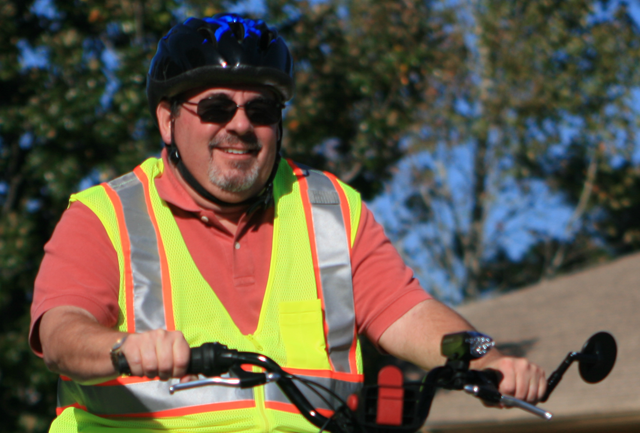
By John Alexander
The old expression, “Just like Riding a Bike,” is often used to describe something that comes second nature and should be easy to do. It implies that we know everything about an activity and can take off where we left off. That couldn’t be farther from the truth when it actually comes to “driving” a bike — we can always learn more and continuously improve our skills.
As a kid I loved zipping around on my bike and was very proud when I saved up enough money to buy twin newspaper baskets, which made me an entrepreneur. In college I was fearless, easily navigating 4” bike trails through the woods from the dorm to class. For a long time after that, I put didn’t spend any time on a bike. A couple of years ago I purchased an Electra Townie bicycle to renew my bike riding habit and improve my fitness. For the most part, the bike sat comfortably parked in the garage. At the beginning of this year I finally followed through and dropped 30 pounds by using a treadmill, which also prompted me to dust off the bike and begin riding. Portions of the Cross Seminole Trail run near my house and I began to take advantage of the fun of short rides.
All went well until I ventured off to another part of the “trail” — really a sidewalk— and experienced my first crash. An approach to a narrow bridge over a creek consisted of a 90 degree left turn, immediately followed by a 90 degree right turn — after a downhill approach. I was going too fast and smacked into the sturdy guardrail, reinjuring a shoulder that I had just rehabbed from a torn rotator cuff. My garage door opener flew out of my basket and into the creek, but I stayed upright, though frustrated and discouraged. An acquaintance put me in touch with Mighk Wilson as a result of that incident and I began to follow the work that he was doing to improve bike safety.
After reviewing the information on the Cycling Savvy Course, I decided to invest some time and energy into the program to improve my skills and give myself more confidence. Friday evening was the classroom session. Even though I am 59 years old, I was nervous as I entered the room and wondered if I was “out of my league.” Everyone made me feel welcome and included — from the instructors to my fellow classmates. I quickly learned that the group consisted of a variety of ages and skill levels and immediately began to relax.
Right out of the gate, Mighk and Keri opened our eyes to several myths about bike riding and the new vision for safe and effective two wheeled transportation, which applies equally well to both the novice and the daily urban bike commuter. They supported their case with extremely well prepared videos and animations to demonstrate each aspect of this “technical” portion of the program. As a trainer myself, I could clearly see that they had found a way to break through to the adult learner. My classmates and I were not only being informed, but were being challenged to rethink what we knew about cycling. It was exhilarating to realize that we were being empowered to “lead the dance” out on the road.
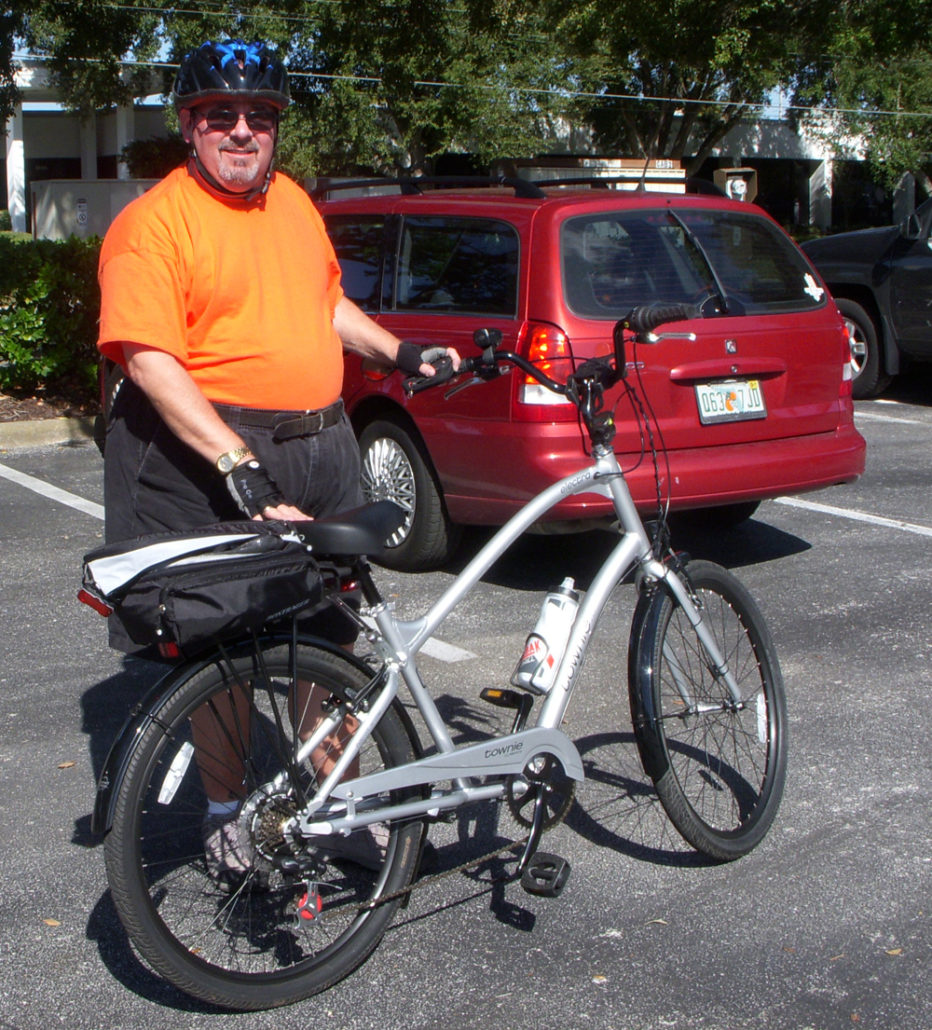
I arrived a few minutes before the designated start time on the Saturday morning. I had checked my tire pressure the night before, so I was very surprised to discover that I have a flat tire when I removed my bike from the car rack. One of my classmates, Randy — a UCF professor — immediately sprang into action and patched the flat but it didn’t hold. Mighk kindly loaned me a tube to use and informed me that the inner band on the wheel had deteriorated and was allowing the end of one of the spokes to pierce the tube. I followed his advice and promptly folded up a dollar bill to cover the errant piece of metal. Although slightly embarrassed that I’d held up the group for a few minutes, I felt a sense of camaraderie with both my trainers and classmates. They weren’t going to leave anyone behind. This was going to be fun.
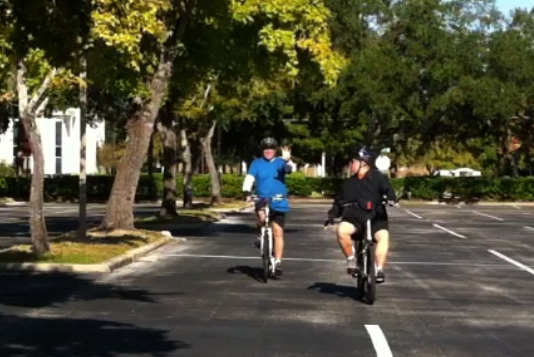
And fun it was! Though not always easy. The three hour bike handling skills took place in a large open parking lot. Each drill was carefully designed to improve our comfort, confidence, and command over our “vehicle” — our bikes. Snail races, using gears for quick acceleration, super slow tight turns, balancing after stopping, shoulder checks, and evasive snap drills led to high speed turns and emergency stops. The “building blocks” all came together by the end of the morning, with each of us now possessing a “tool bag” of essential bike-handling skills.
We had ridden several miles criss-crossing that parking lot and next on the agenda was lunch. Only one thing was standing between us and a tasty burrito — navigating down Maguire and turning right onto Colonial Drive, crossing three lanes of traffic and executing a left-hand turn onto Primrose Ave. ARE YOU CRAZY ????? Between the faith that we’d placed in our instructors and the new found confidence that we had in our individual ability, the class ventured out and successfully and flawlessly completed that first “feature” as a group. Collectively, we realized, “We can do this!” As with many of the other specific tasks that we would face throughout the afternoon, our trainers mapped out the plan with colorful chalk on the pavement, explained both the hazards and the best approach that would ensure ease and safety. Getting the first exercise under our belt, followed by a collective “high five” was a glorious moment.
The afternoon was spent analyzing and facing down several other features. This experiential form of training was perfect for adult learners. We weren’t being lectured to. We weren’t being given some meaningless test. We were part of the learning process and the success of each individual in the class was just as important to us as our own small victories. We rode together between exercises, but were given the opportunity to personally experience each feature on our own. From riding through a round-a-bout to learning the proper way to cross diagonal railroad tracks, to seamlessly controlling the center lane on Princeton to avoid the I-4 on-ramp, to navigating the fearsome Ivanhoe Interchange (not once, not twice, but three times), each exercise brought us a new level of confidence.
After making our way through the construction near the new Arena, we had to cross the bridge over I-4 on Anderson. That climb was a challenge, I downshifted so far that there was only one gear left — my internal “Little Engine That Could” — but I made it to the top and was rewarded with a swift ride down the other side. I learned a lot about my bike that day too — after cresting that hill, Keri rode up next to me and said, “Yeah, your Townie is great for stopping, no so much for climbing” and then told me she was proud of me for toughing out that hill. At that point of the day, my competence and confidence were soaring — I wasn’t going to fall behind my classmates in any way.
It dawned on me that I was riding side by side with him just a shoulder width apart and tracking exactly one wheel length behind the rider in front of me — and I was perfectly relaxed, comfortable and having a blast.
One of the reasons I took the Cycling Savvy Course was that I had begun to feel uncomfortable riding on sidewalks to get to the trail in my area. I learned that there were plenty of good reasons to feel that way — uneven and broken sections of sidewalk, the need to steer around pedestrians and other bikes, the possibility of a wheel getting caught between the sidewalk and deeply edged grass which could lead to a fall and the higher risk of being hit by a car. I had feared that my balance was an issue. By going through the course, I had plenty of opportunities to disprove that assumption and build my skills. As we were riding in a group at the end of the day, I was carrying on a great conversation with one of my classmates, Harry, about cruises that we had taken. It dawned on me that I was riding side by side with him just a shoulder width apart and tracking exactly one wheel length behind the rider in front of me — and I was perfectly relaxed, comfortable and having a blast. This program helped me to realize the freedom and fun that comes with being in command of your own bike. I was a kid again!
Since the class, I have ventured out to the trail several times — now comfortably doing 10 mile routes without breaking a sweat. I participated in my 1st “First Friday” night ride with several of the Commute Orlando and Cycling Savvy group — a fun, social way to spend an hour or so, and a way to share the message that bikes can co-exist with cars on the road. This weekend I will be headed out for a Holiday Light ride — what better way to see the decorations? I’ve begun to set new goals as well. After hearing about people taking 500 mile bike trips, I’ve begun logging my miles with “500” as my first target. I might reach it by only pedaling 10 miles at a time, but I’ll get there — with a smile on my face.
The support and inspiration that Mighk and Keri have provided has been tremendous. She definitely “had my back” while we were riding the final leg back to the parking lot during the class. While riding along, I felt my wedding ring slip off my finger. Using a skill that I had learned that morning, I turned around in the saddle and told her that my ring had fallen off. She said, “I know, I just rode over it.” She promptly went back and retrieved the now “flattened” ring. If she hadn’t trapped it under her wheel, it might have rolled off into a gutter. Nice save! More significantly, I mentioned to Keri that I was looking for a better way to get to a portion of the trail in my area. She came up to Lake Mary and helped me evaluate several options and then rode the route with me — capturing it all on a video. She wrote a fantastic article about that experience, which can be viewed here.
I was diagnosed with Parkinson’s disease at the beginning of 2010. I have learned that active bicycling has been proven to reduce some symptoms.
One last little detail that I would like to share is the fact that I was diagnosed with Parkinson’s disease at the beginning of 2010. At this point, my primary symptoms are a “resting tremor” in my left hand and leg which is being effectively managed with a low dose of medication. I am very much aware of changes to my system and how they may affect my ability to live my life. I have learned that active bicycling has been proven to reduce some symptoms. I love my bike. I love the freedom that I feel when I am riding it. One of my strengths, according to a survey that I recently took, is “Positivity.” I am confident that I can take on this “unknown challenge.” To me, it’s just another “feature” to be mapped out and “ridden” through. With the new skills that I’ve learned through the Cycling Savvy experience, I will be a safe rider for a very long time. Michael J. Fox, as a spokesperson for PD, naturally is one of my heroes these days. While traveling through the Atlanta airport recently I saw a billboard with his photo and the message “Out Fox Parkinson’s.” That’s my plan too. I close this post with a link to a video he produced — “What is Optimism?”

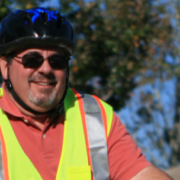
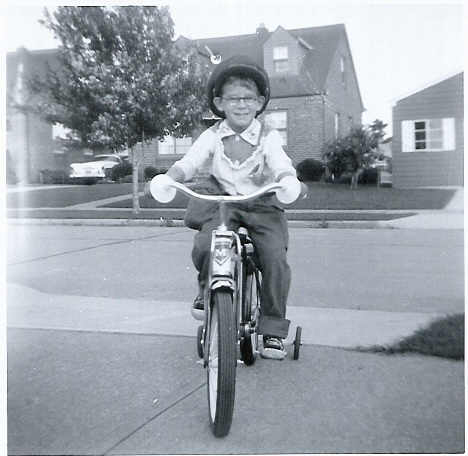



Thanks very much for sharing your experience. I’d read Keri’s article of your experience, and it’s always fun to see both sides of the picture.
Some of us “experienced” safe-cyclists have begun to take some things for granted, in a manner of speaking. Your fresh viewpoint only serves to show us again how much fun it is to ride safely. It’s also great fun to see others such as yourself experiencing this for the first time.
I’m glad to hear that your medical condition is under control enough to enable you to enjoy riding. There are many recumbent riders with more severe conditions who ride two- and three-wheeled recumbents, but don’t have the advantage that you do with the Cycling Savvy course behind you.
May you have many more happy miles ahead of you.
There are many recumbent riders with more severe conditions who ride two- and three-wheeled recumbents, but don’t have the advantage that you do with the Cycling Savvy course behind you.?
This sounds like a great course — I believe I can always learn something more. I’ll have to see if I can find something similar here in the suburbs of Philadelphia.
Best,
Rob
riding an exercise bike at over 80 rpms for 40-50 minutes has been shown to reduce PD symptoms (Cleveeland Clinic studies). amd it works for me. Adding dance (Nia, tap, moving to music) snf movement that requires learning (tango) also helps. Keep on using youur body and practicing the movmenets you want to reinforce. suggested readings: Becky Farle on exercise and PD. articles by Mark Hirsch, Beth fisher
Best wisihes!! Keep o pedalling